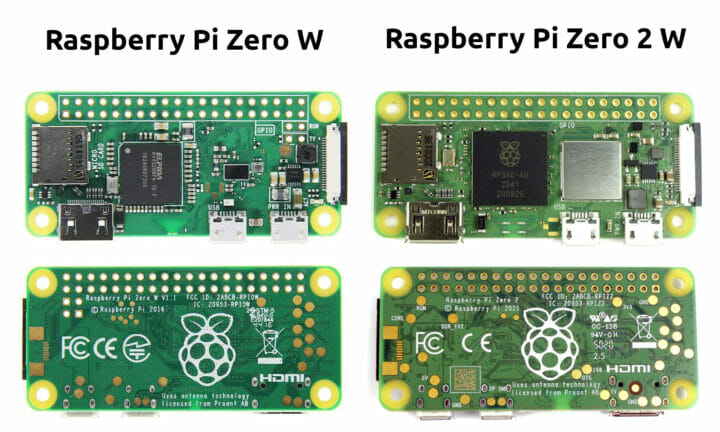The Raspberry Pi Zero 2 W quad-core board has just launched, and in this post, we’ll look at how the new board compares to the original Raspberry Pi Zero W SBC. From the photos above they are nearly identical, but looking at the detailed specifications, we’ll find some interesting differences.
Raspberry Pi Zero W | Raspberry Pi Zero 2 W |
|
|---|---|---|
| SoC/SiP | Broadcom BCM2835 | Raspberry Pi RP3A0 with Broadcom BCM2710A1, 512MB RAM |
| CPU | Single-core Arm11 @ 1 GHz | Quad-core Cortex-A53 @ 1 GHz (overclockable to 1.2 GHz) |
| GPU | VideoCore IV |
|
| Memory | 512MB DDR2 PoP | 512MB DDR2 wire-bond |
| Storage | MicroSD card |
|
| Video & Audio Output | Mini HDMI |
|
| Camera | MIPI CSI-2 camera connector |
|
| Video | Decoding - H.264 and MPEG-4 up to 1080p30 Encoding - H.264 up to 1080p30 |
|
| Wireless | 802.11 b/g/n WiFi 4, Bluetooth 4.1 LE with PCB antenna | 802.11 b/g/n WiFi 4, Bluetooth 4.2 LE with PCB antenna, but improved design |
| USB | Micro USB OTG port |
|
| Expansion | 40-pin GPIO header (unpopulated) |
|
| Power Supply | 5V/1.2A | 5V/2.5A |
| Dimensions | 65 x 30 x 13 mm |
|
| MSRP | $10 | $15 |
| Release date | 28 February 2017 | 28 October 2021 |
| Recommended operating system | Raspberry Pi OS |
|
So the main reasons to get a Raspberry Pi Zero 2 W over a Raspberry Pi Zero W is the extra performance enabled by the quad-core Cortex-A53 processor and possibly better wireless performance. The downsides are at the new board costs $5 more, and power consumption might be higher, but this would have to be tested under various scenarios. Another reason you may end up getting the Zero 2 W board that is not shown in the specifications is the recent shortage of chips, so the new board may be more likely to be in stock at your local distributor.

Jean-Luc started CNX Software in 2010 as a part-time endeavor, before quitting his job as a software engineering manager, and starting to write daily news, and reviews full time later in 2011.
Support CNX Software! Donate via cryptocurrencies, become a Patron on Patreon, or purchase goods on Amazon or Aliexpress





